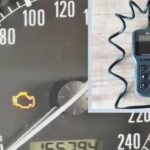The Bosch ProGrade OBD2 scan tool, though discontinued, remains a powerful diagnostic solution for vehicle owners. This article explores the features and functionality of the Bosch OBD 1350, highlighting its capabilities in reading and clearing trouble codes, accessing live data, and performing various diagnostic tests. While Bosch no longer produces this specific model, understanding its capabilities can provide valuable insight when choosing a current OBD2 scanner.
Comprehensive Vehicle Coverage and System Diagnostics
The Bosch OBD 1350 provides extensive coverage for Domestic, Asian, and European vehicles, including models from GM, Ford, Chrysler, Toyota, Honda, Nissan, Hyundai, BMW, Mercedes, Smart, VW, Audi, Jaguar, Land Rover, and Volvo. This broad compatibility makes it a versatile tool for diagnosing a wide range of vehicles. The scanner excels in reading and displaying ABS codes and SRS/airbag codes across numerous makes and models, enabling quick identification of issues within these critical safety systems.
Enhanced Datastream and Diagnostic Tests
Beyond basic code reading, the OBD 1350 offers enhanced Powertrain/ABS datastream capabilities, providing real-time insights into vehicle performance. For Ford vehicles, it performs ‘On Demand’ tests, allowing users to activate switches and actuators for diagnostic purposes. The integrated CodeConnect database, containing over 26 million fixes, provides probable causes for warning lights, aiding in efficient troubleshooting. Moreover, the tool provides enhanced live datastream for GM and Ford transmissions and monitors fuel mileage metrics like MPG, average MPG, elapsed time, distance traveled, fuel consumption, and average speed.
Advanced Features and User-Friendly Interface
The AutoID function automatically retrieves vehicle data for most models from 2000 and newer, streamlining the diagnostic process. The OBD 1350 can reset oil lights, check engine lights, and perform battery life resets. It supports all modes of OBD II global data, including Mode 6 and O2 monitor tests. The device also monitors battery, alternator, and charging systems. Data graphing (for 1996 and newer vehicles) allows for visual analysis of sensor data, which can be recorded and played back for review.
Additional Functionality and Multilingual Support
The OBD 1350 reads, displays, and erases generic and enhanced diagnostic trouble codes (DTCs). It provides access to freeze frame data, emissions readiness status (I/M readiness monitors), and a built-in OBD II code library. The tool boasts PC compatibility for data management and features a large, backlit, graphic LCD screen for clear visibility. Powered by a battery, the device allows for off-vehicle data review. Menu navigation and options are available in English, French, and Spanish, catering to a broader user base. The Bosch OBD 1350 is compatible with all 1996 and newer import and domestic vehicles compliant with OBD II standards, including ’94 and ’95 OBD II compliant vehicles.
Conclusion
The Bosch ProGrade OBD2 scan tool (OBD 1350) offers a comprehensive suite of features for diagnosing vehicle issues. Although discontinued, its capabilities demonstrate Bosch’s commitment to providing robust diagnostic solutions. While the OBD 1350 is no longer available, its features serve as a benchmark when considering modern OBD2 scan tools. Understanding the functionalities of this advanced tool can assist in selecting a replacement that meets specific diagnostic needs.

